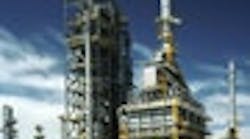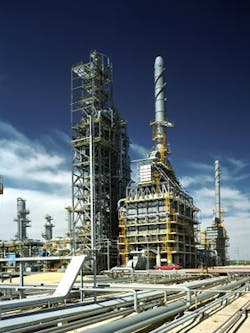Pressure to reduce water consumption and switch to other, often lower-quality, sources is prompting a major rethink about how chemical companies manage and use their water resources. Optimization has become a corporate mantra.
"An increasing challenge is water scarcity and ensuring that the population has enough for their needs, so we are seeing increasing restrictions on where industry can get water -- plus increasing cost. Industry is also seeing significant increases in wastewater sewer fees -- disproportionately so compared with homes," notes Derek Miller, North American industrial water manager, Air Products and Chemicals, Allentown, Pa.
"Our customers are facing three pinches in terms of their water utility footprints," says Glen Messina, global business leader, chemical monitoring solutions business -- water and process technologies for GE Power & Water, Trevose, Pa.
First, global constraints on the supply of fresh water are growing: regulations now are beginning either to prevent companies from using municipal fresh water or taking more from rivers.
Second, companies face declining water quality -- for example, plants more and more must take discharge water from municipal treatment plants.
Third, increasingly stringent regulations worldwide govern discharges, even sometimes banning them. Traditional tailing ponds are being closed down, so new ways are needed to recondition the water.
VENDORS RESPOND
"Between 2006 and 2010, we doubled our investment in the technologies in these areas and we expect this to double again in the next three to five years. We think we have a significant advantage here because of the breadth of our portfolio," notes Messina.
The company has launched an advanced system for cooling water. This comprises GenGard anti-fouling and anti-corrosion treatment coupled with the TrueSense automation and control platform that allows continuous monitoring and dosing of the cooling water.
GE also offers a broad portfolio of filtration systems, including basic paper cartridges, reverse osmosis (RO), ultrafiltration, membrane bioreactors (MBRs), electrodialysis, electrodialysis reversal and electrodeionization.
"These systems allow us to take a raw discharge and convert it into drinking water quality. Industrial users today want to meet regulatory standards for either discharge or recycling back into the front end of their processes," explains Messina.
In addition, the firm has established an integrated water solutions group to help customers look at the water utility footprint of existing plants and to offer engineering services for new plant construction. "…More than a dozen of the Fortune top 50 companies have approached us to carry out an evaluation of their existing water utility footprints," he notes.
GE Power & Water has dramatically decreased its own water usage. In 2008 the company set a goal of a 20% reduction (versus a 2006 baseline) by 2012. It achieved a 30% cut by the end of 2009 and is now working on the next benchmark.
"Each application is customized for each of our plants: there is no cookie-cutter solution. At the same time it is important to remember that some of these improvements are based on changing operations. For example, a simple re-routing of water pipes reduced usage at one site. So cold water flow redesign can be very important while not being a major capex [capital expenditure]."
Looking to the future, Messina points to the challenges posed by the need to remove heavy metals such as mercury. In some countries, the legal requirement is for five parts per trillion: "This is a very complex demand to deal with and there's no one magic solution: a combination of technologies will be needed to achieve this."
Dow Water & Process Solutions, Edina, Minn., is focused on the twin requirements of reduced costs and increased sustainability.
"Industry generally will have to be very, very much more efficient so that water use can be focused on using it for drinking and food production. Reducing water use and then reusing it in the system is therefore becoming more important for the formation of long-term, sustainable enterprises," says Snehal Desai, global marketing director.
One major technology focus for the company is a new fouling-resistant (FR) series of filters for waste treatment centers. "This is particularly important in the production of chloralkalis, which requires a lot of water. Standard RO technology was used by one customer to recycle the water, but they wanted to increase the times between filter cleanings," notes Desai.
Customers increasingly are talking about the net energy footprint to treat water (Figure 1), too, prompting Dow to develop low energy technologies that, for example, need less pressure drop across filters. A low energy FR technology is due to be launched later this year.
MBRs are finding greater use to reduce the organic and suspended load in water streams, which then can be polished further with an RO system. Desai points to the new M20 series of MBR technologies as being crucial for users that need to produce water that can be re-used again in the process stream.
He also cites geographic challenges. "Companies on the Houston Ship Canal have big issues with fouling because the surface water can be very dirty there. On the Gulf Coast, the challenge is to provide cost-effective desalination technology. In China it also depends on sector and location of the plant, but the government is being very aggressive now in pushing water cleanliness."
Dow Water & Process Solutions is focusing its R&D efforts on three main areas: improved rejection of salt from water, lower energy use and better fouling resistance.
Typically, required salt rejection is 99.5–99.7% but ultrapure water, which is a rapidly growing market, demands even better performance -- this often involves RO coupled with ion exchange. One of the big costs here is resin regeneration; the company now is actively working on this.
Work also is advancing on nanofiltration. This is important where divalent ions such as calcium and sulfate must be rejected. For example, in oil production, injecting water with a high sulfate level increases scaling in wells.
PLANT INITIATIVE
Bayer HealthCare aims to reduce water consumption at its Berkeley, Calif., site by 10% by 2015 from a 2010 baseline. "We know exactly what our total water consumption is and the volume of our waste stream, so we can drill down and see exactly how much water is used in each process, each building and so on," says Thomas Daszkowski, vice president, BTS Process Technology (BTS). BTS is the technological backbone of the Bayer group worldwide, developing and implementing process and plant optimization for the company.
One of the major uses of water at Berkeley is in cleaning operations. They rely on high purity water also known as water-for-injection (WFI). Such water is expensive because it has to be purified by processes such as RO or distillation and then stored and distributed at high temperature. So reducing its use also pares site demand for natural gas and electricity. "Our evaluation has showed us that all our resources are linked, and making a conscious effort to reduce one resource can help reduce our overall consumption as well," notes Daszkowski.
Operations are benefiting from a new skid, designed by the Berkeley site's PAT [process analytical technology] group, to minimize over-cleaning. "This skid includes many of the types of analytics such as a total organic carbon (TOC) analyzer, dual wavelength UV analyzer, a pH analyzer, and conductivity analyzers that are used for cleaning validation, all packaged together in a real-time, inline process monitoring tool," says Chris Williams, BTS PAT manager. Early use of the skid points to a number of pluses, including an average water consumption reduction of up to 50%.
Pipeline projects are reaping benefits too. "The project team has looked at many other water savings through redesign of old systems. The RO system in one of our buildings sends close to 8 million gallons of water a year into our drains. Repiping the drain to our cooling towers lowered our consumption of city water and helped us reduce site consumption by approximately 7%," says Arun Nedungadi, sustainability engineer.
Another project reuses tower water that cools clean steam condensate, saving about 2.5 million gallons of water annually. "In addition, 1.5 million gallons of condensate that was being sent to drain is now being redirected to our main steam plant where a redesign of oversized pumps has halted excessive water-hammering," adds Nedungadi.
"Overall, these projects have helped cut water consumption at the Berkeley facility by 12 million gallons, approximately 10% of the total in 2010 -- this is a major step forward in helping us realize our 2015 goals," explains Ron Roberts, principal engineer, central utilities.
A key aspect of sustaining these changes is to engage company employees in the conservation efforts. "We will be looking to include employees in identifying and implementing projects by having dedicated energy teams for our mission-critical buildings on site," says David Woodard, principal, health environment & safety group.
WASTEWATER FOCUS
As part of its overall sustainability goals, Air Products is committed to cutting its water consumption by 10% by 2015 versus 2009, and is promoting water reuse.
In addition, the company is helping its industrial clients improve wastewater treatment: "For industrials that have wastewater treatment plants, they can face challenges meeting production capacity changes. The desire to increase treatment capacity without major capital investment is a good application for oxygen," explains Miller. Retrofitting pure oxygen onto existing processes that rely on air and activated sludge can double treatment capacity (Figure 2), while adding high efficiency mixers at the same time can reduce power consumption by up to 50%, he notes.
Air Products also is helping customers to reuse their own wastewater, especially when significant quantities of organics or nutrients are present and use of oxygen is a good fit. There's a strong focus on MBRs because they are high-intensity, have a small footprint and produce very high quality water that can be reused in a number of on-site applications such as cooling-water makeup.
"However, while you get a lot more treatment/volume with an MBR, the use of high sludge concentrations can lead to limitations getting sufficient oxygen into the wastewater using conventional air-based aeration. So we believe that the optimum MBR design would run on pure oxygen. We have a couple of these up and running now in industrial applications and are close to commercializing a further optimized system," he reveals.
Overall, the company sees an increasing drive from industry to do more wastewater treatment in less space, reduce waste disposal costs and extract value in the form of water reuse and energy. "We are working to make our oxygen technologies more efficient and, with partners, are developing complete treatment systems designed to take advantage of the benefits of oxygen," he says.
REDUCING INTAKE
At its Rotterdam site in the Netherlands, Akzo Nobel has cut fresh water consumption while increasing the concentration of saline water that its treatment plant can handle. Salt concentration has risen from its original maximum concentration of 2% as process intensification and expansion projects took place.
"Our first choice, an anaerobic biological system, did not work. But we found we could use an aerobic system instead. By slowly creating and maintaining a biomass that was adjusted to the higher salt concentrations, we were able to operate at 3% salts. Large water savings were realized and we could operate the installation at a higher total capacity," notes a spokeswoman.
At its Delfzijl, the Netherlands, site, Akzo has installed an efficient co-generation plant to generate steam for a multi-effect evaporation process, with condensate purified and reused in a continuous recycling system.
Half a world away, the BP refinery in Kwinana, Australia, (Figure 3) now sends its wastewater to a water recycling plant instead of discharging it into the Cockburn Sound. In addition, the company is taking in treated sewage water from a nearby effluent plant. This water, treated by intense microfiltration and RO, is so pure that it would leach metal from standard piping. So BP has installed glass-reinforced epoxy pipelines.
Seán Ottewell is Chemical Processing's Editor at Large. You can e-mail him at [email protected].




